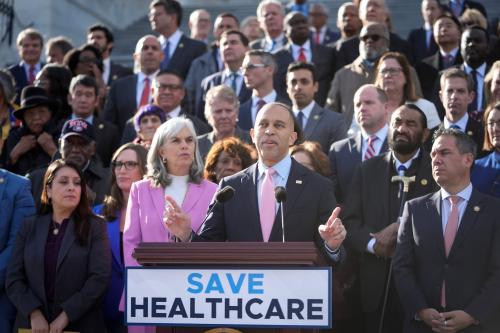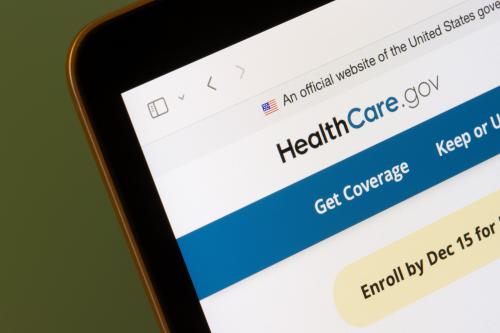This analysis was updated on October 22, 2025. Due to a misinterpretation of the timing of an underlying data source, the original version of this analysis underestimated the share of Marketplace enrollees with $0 net premiums in 2025 and, in turn, underestimated the effect of a minimum premium requirement on Marketplace enrollment and federal spending. The revised analysis updates these estimates. The author regrets the error and thanks Andrew Sprung for bringing the issue to his attention.
In 2021, Congress increased the generosity of the premium tax credit, which helps people who buy coverage via the Health Insurance Marketplaces pay their premiums. Lawmakers are currently debating whether to extend these changes beyond their scheduled expiration at the end of this year. If the changes do expire, the reduction in federal subsidies would sharply increase enrollee premiums, causing an estimated 3.8 million people to become uninsured, while saving the federal government around $35 billion per year over a decade.
Press reports suggest that some lawmakers are considering extending the enhanced credits but adding a new provision that would prevent the premium tax credit from reducing an enrollee’s premium all the way to $0, as can sometimes occur for low-income enrollees who choose low-cost plans (under both the current tax credit parameters and under the less generous parameters in effect prior to 2021). This piece examines who this change would affect and what it would mean for insurance coverage. Notably, I estimate that if such a minimum premium requirement had been in effect in 2025, it would have caused 960,000 people to lose their Marketplace coverage, mainly by creating an additional administrative barrier to enrolling and staying enrolled, while reducing federal costs by around $7 billion, with these savings driven by the reduction in insurance coverage.1
Why do some Marketplace enrollees currently pay $0 for coverage?
Most people who enroll in health insurance through the Health Insurance Marketplaces receive a tax credit to help pay their premiums. The credit is equal to the premium of a “benchmark” plan (the second-lowest-cost silver plan available to an enrollee) less an expected enrollee contribution that rises with income and falls with family size.2 Enrollees may apply the credit to any Marketplace plan. If the enrollee’s credit is greater than or equal to their plan’s premium, then the enrollee generally pays a net premium of $0.3
To pay a $0 net premium, an enrollee generally must both have a low income and have chosen a low-cost plan. Under the tax credit parameters in effect for 2025, enrollees with incomes below 150% of the federal poverty level (FPL), which is currently $22,590 for an individual or $46,800 for a family of four, the tax credit covers the full cost of the benchmark plan.4 Thus, enrollees at this income level generally have a $0 net premium if they select one of the two lowest-cost silver plans available to them or certain bronze plans.5 Enrollees with somewhat higher incomes also generally have at least some plans with a $0 net premium available to them, but typically only in the bronze tier. It is worth noting that around 15% of Marketplace enrollees in the states that used the HealthCare.gov enrollment platform had plans with $0 net premiums even before implementation of the enhancements to the premium tax credit made in 2021, so this is not a new phenomenon.
The Marketplaces are not the only public coverage program in which some enrollees do not pay premiums. State Medicaid programs are generally not permitted to charge premiums. Similarly, low-income Medicare beneficiaries are generally not required to pay premiums to enroll in Medicare because those premiums are paid by Medicaid or, in the case of prescription drug coverage, the Part D Low Income Subsidy program. And essentially all Medicare beneficiaries have access to Medicare Advantage plans that offer drug coverage and other supplemental benefits at no premium beyond the base Medicare Part B premium.
A substantial research literature has examined how being subject to a $0 premium—as opposed to a small positive premium—affects insurance enrollment outcomes. Across a variety of settings, the clear finding is that being required to pay a premium, even a very small one, meaningfully reduces enrollment relative to being subject to no premium at all.6
Two studies have examined this question in the Marketplaces specifically. One study examined instances in Massachusetts’ Marketplace in which an enrollee’s plan changed from having a $0 premium in one year to a $1 premium the next plan year. The authors estimate that enrollment was 12% lower among those subject to a $1 premium relative to those who remained subject to a $0 premium. Another study examined Colorado’s Marketplace and compared people just above and just below income thresholds at which enrollees lost eligibility for $0 bronze plans; the results imply that being subject to a positive premium reduced enrollment by 8-16% (depending on the precise methodology used).7
Research has also examined this question in contexts beyond the Marketplace. A study of Wisconsin’s Medicaid program compared enrollment outcomes just above and just below an income threshold at which the state applied nominal premiums to some enrollees. It finds that being subject to a premium reduced average enrollment duration by 13%. Similarly, a study of Massachusetts’ pre-Affordable Care Act insurance exchange examined instances where enrollees newly became subject to a small positive premium at the start of a new plan year (much like in the study of Massachusetts’ Marketplace described above); it finds that being subject to a small premium would have substantially reduced coverage absent a state policy that automatically transitioned enrollees back to $0 coverage.
These studies also examine why being subject to even a very small premium reduces enrollment. In each case, the main factor appears to be that paying a premium adds an additional administrative step to the process of enrolling and staying enrolled in coverage: remitting the premium. That step appears to trip up some enrollees.
Estimating effects on insurance coverage and federal costs
The research findings described above can be used to estimate the enrollment effects of a policy that eliminated $0 net premiums by requiring all Marketplace enrollees to pay some minimum positive premium (e.g., $1 per month). Concretely, I aim to estimate how such a requirement would have affected outcomes if in effect in 2025.
Effects on insurance coverage
The first step is to estimate the number of Marketplace enrollees with $0 net premiums in 2025. While a suitable estimate has not been published, the 2025 open enrollment public use file shows that 42% of Marketplace plan selections during 2025 open enrollment had a net premium of $10 per month or less. For the states that use the HealthCare.gov enrollment platform, these data and an accompanying report show that 81% of plan selections with a net premium of $10 per month or less in fact had a $0 net premium.8 Extrapolating this percentage nationwide implies that 34% of Marketplace plan selections during 2025 open enrollment had a $0 net premium. Applying that percentage to the total number of people with Marketplace coverage as of February 2025 (23.4 million) then implies that around 8.0 million current Marketplace enrollees are enrolled in plans with a $0 net premium.
Based on the studies reviewed above, a reasonable estimate is that being subject to a small positive premium reduces enrollment by around 12%.9 If 12% of enrollees with $0 net premiums were disenrolled, that would amount to around 960,000 people. Since people are only eligible for subsidized Marketplace coverage if they lack another source of affordable coverage, most or all of these people would likely become uninsured.
This estimate has a couple of limitations worth noting. First, I estimate the effect of requiring all enrollees to pay a de minimis premium (e.g., $1 per month). Increasing premiums beyond a de minimis level would reduce enrollment by more, as there is clear evidence that the size of premiums also affects enrollment outcomes. For example, the study of Massachusetts’ Marketplace cited above finds that the enrollment effect of a $9 per month premium is about 50% larger than the effect of a $1 per month premium.
Second, I estimate the effect of this type of policy if it were in effect in 2025. Even if the 2021 enhancements to the premium tax credit are extended, other aspects of federal policy toward the Marketplaces are poised to change. In recent months, policymakers have made both legislative and administrative changes expected to reduce Marketplace enrollment, which would likely reduce the number of Marketplace enrollees with $0 net premiums. This implies that a minimum premium requirement would likely have a somewhat smaller effect on enrollment in the future than it would have had if it were in effect in 2025.
Effects on federal costs
Removing these people from coverage would also reduce federal costs. If the average gross premium among these enrollees matched the Marketplace average as of February 2025 ($618.76), then federal costs would decline by around $7.1 billion.
While this estimate is a good guide to the general magnitude of the federal savings, it likely overstates them to some degree. There are three main reasons for this. First, the average gross premium for enrollees with $0 net premiums is likely lower than the market average since, as noted above, $0 net premiums are only available on relatively low-cost plans. Second, some enrollees with $0 net premiums during the plan year might be required to pay back a part of their subsidy when filing their taxes if their income was higher than expected.
Finally, my calculations neglect any effect of lower enrollment on the individual market risk pool. One of the studies cited above directly examines the claims spending of people who lose coverage when required to pay a positive premium and finds that they have below-average claims spending; two others examine heterogeneity in these effects by age and find that imposing a small positive premium tends to have larger effects on younger enrollees. This suggests that a minimum premium requirement would increase individual market premiums, thereby eroding the federal savings from this policy.
Some observers have raised concerns that a large fraction of Marketplace enrollees are “phantom” enrollees who are unaware that they have Marketplace coverage, either because they were enrolled in coverage without their knowledge by a broker or have transitioned to another form of coverage without ending their Marketplace coverage. Supporters of a minimum premium requirement may hope that imposing such a requirement would do little to harm people who legitimately rely on the Marketplaces, while generating large federal savings by screening out many phantom enrollees. These hopes are misplaced.
First, the evidence reviewed above leaves little doubt that a minimum premium requirement would cause many people who rely on their Marketplace coverage to lose it. In 2021, around 15% of Marketplace enrollees in the states that used the HealthCare.gov enrollment platform were paying $0 net premiums even under the old tax credit parameters, and that fraction would have been much higher under the current credit parameters. Since 2021 predates the current concerns about phantom enrollments, this provides clear evidence that a large share of Marketplace enrollees with $0 net premiums are not “phantoms.” Moreover, the research I use to estimate how much a small premium reduces enrollment is from settings where phantom enrollments were likely quite rare. In particular, all of the research I review examines data for 2019 or earlier, and one of the studies was able to directly examine rates of duplicate enrollment using state all-payer claims data, finding that it accounted for a very small fraction of enrollees. It follows that the enrollment effects of a minimum premium requirement would stretch far beyond phantom enrollees.
Second, it is far from clear that phantom enrollments account for a large fraction of Marketplace enrollments with $0 net premiums. While there is compelling evidence of some fraudulent broker-driven enrollments, that evidence does not demonstrate that the number of such enrollments is large relative to Marketplace enrollment overall or the population of people with $0 net premiums in particular. And other evidence cited to claim that phantom enrollees account for large swaths of Marketplace enrollment has very serious flaws.
Moreover, even if phantom enrollments were widespread in the recent past, this is unlikely to remain the case going forward. The federal government has recently taken targeted steps to address broker fraud. Other recent steps, especially changes to enrollment and re-enrollment procedures in recent reconciliation legislation, are likely to screen out most of any phantom enrollees who remain (albeit likely at the cost of substantially reducing enrollment among legitimate enrollees as well). Thus, the scope for a minimum premium requirement to reduce phantom enrollments, if it was ever large, is fading fast.
Third, and perhaps surprisingly, removing phantom enrollees from the Marketplaces would likely generate little federal savings. To see why, suppose that policymakers removed a large number of phantom enrollees from the market. Phantom enrollees do not file claims, so average claims spending would rise. Premiums would follow average claims spending, and the value of the tax credits that enrollees receive would follow premiums. Thus, while the federal government would subsidize fewer people, it would pay more for each enrollee that remains. On net, the federal government would likely save little, if anything.10 (It is also worth noting that the increase in premiums means that unsubsidized enrollees would pay more.)
To be clear, insofar as some enrollees with $0 net premiums are, in fact, phantom enrollees, this would affect my numerical estimates of the effects of a minimum premium requirement. In such a scenario, the reduction in Marketplace enrollment from a minimum premium requirement would be larger than I estimate (since phantom enrollees would be disenrolled at a rate higher than the 12% rate reflected in my estimates). On the other hand, the ultimate effects on insurance coverage and on federal costs would be smaller (since some of those being disenrolled would be people who do not rely on that coverage), although the discussion above implies that both would remain sizeable. Because the effects on insurance coverage and federal costs would shrink in parallel, the core tradeoffs associated with applying a minimum premium requirement would remain essentially unchanged.
Conclusion
Requiring all Marketplace enrollees to pay a positive net premium would reduce health insurance coverage among low-income Marketplace enrollees and, correspondingly, reduce federal costs. As such, it presents fundamentally the same tradeoffs as other, more direct ways of paring back federal support for health insurance for low-income people, and policymakers should not imagine that it offers a path to substantial savings with little harm.
-
Acknowledgements and disclosures
The author thanks Christen Linke Young and Aviva Aron-Dine for helpful comments on a draft of this piece, as well as Samuel Peterson and Rasa Siniakovas for excellent research and editorial assistance, respectively.
-
Footnotes
- The original version of this analysis estimated that 430,000 people would lose their Marketplace coverage and that this would reduce federal costs by around $3 billion.
- A silver plan is a plan with an actuarial value of 70%, meaning that, on average, it covers 70% of an enrollee’s health care costs. Enrollees with incomes below 250% of the federal poverty level qualify for cost-sharing reductions that raise the actuarial value of a silver plan above 70%.
- In certain circumstances, an enrollee may pay a positive net premium even if eligible for a tax credit that exceeds the plan’s premium, as the tax credit cannot cover portions of a plan’s premium that are attributable to services that are not considered essential health benefits.
- These figures reflect the 2024 federal poverty guidelines, which is the version of the guidelines used in calculating the premium tax credit for the 2025 coverage year.
- A bronze plan is a plan with an actuarial value of 60%.
- Portions of this literature review are adapted from my prior work.
- For derivation of the 8-16% figure, see my discussion of this paper in prior work.
- Specifically, the public use file shows that 48% of plan selections in the HealthCare.gov states had a net premium of $10 per month or less, while the accompanying report shows that 39% had a $0 net premium.
- This estimate matches the cited estimate from the study of Massachusetts’ Marketplace and is the midpoint between the two estimates from the study examining Colorado’s Marketplace.
- To see why the net effect would likely be small, observe that federal tax credit costs equal aggregate individual market premium revenue less the aggregate amount that enrollees pay. Disenrolling a person with no claims has no effect on aggregate claims spending. Both competitive and regulatory forces tend to align premiums with claims, so aggregate individual market premium revenue is similarly unlikely to change much. The aggregate amount that enrollees pay is also unlikely to change very much since the phantom enrollees themselves pay $0 net premiums, and the large majority of the remaining enrollees are subsidized, meaning that what they pay depends mainly on their income and family structure, not premiums. It follows that aggregate federal subsidy costs are likely to change relatively little following these shifts.There are some caveats to this analysis. Unsubsidized enrollees will tend to pay more as premiums rise, which suggests that federal costs could fall to some degree. On the other hand, if phantom enrollees are overrepresented in silver plans, which is plausible in light of brokers’ incentives, silver premiums would likely rise more than premiums in other metal tiers when phantom enrollees disappear. That would tend to reduce what subsidized enrollees in non-silver plans pay, which suggests that federal costs could actually rise.A final consideration is how removing phantom enrollees could affect the subsidy amounts that the federal government recovers at tax filing. While people enrolled without their knowledge by brokers may not be required to repay subsidies, that may not be the case for people who merely forgot to end their Marketplace enrollment upon transitioning to other coverage. These enrollees could remit less to the federal government if disenrolled, which offers another reason that purging phantom enrollees could actually increase federal costs, albeit principally by imposing additional costs on enrollees who failed to cancel their coverage.
The Brookings Institution is committed to quality, independence, and impact.
We are supported by a diverse array of funders. In line with our values and policies, each Brookings publication represents the sole views of its author(s).





